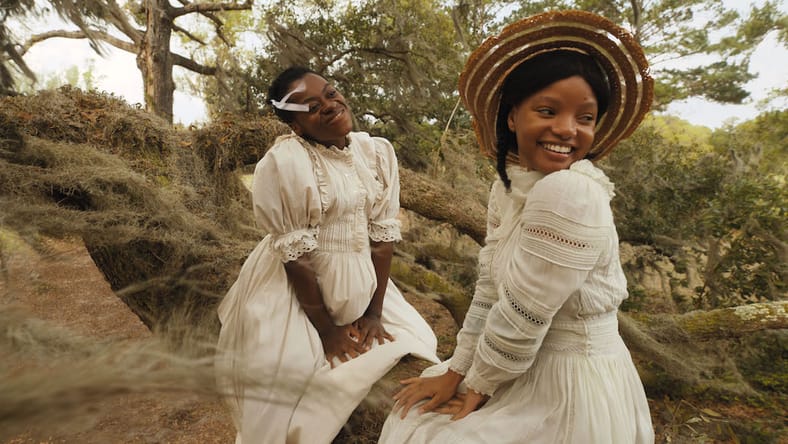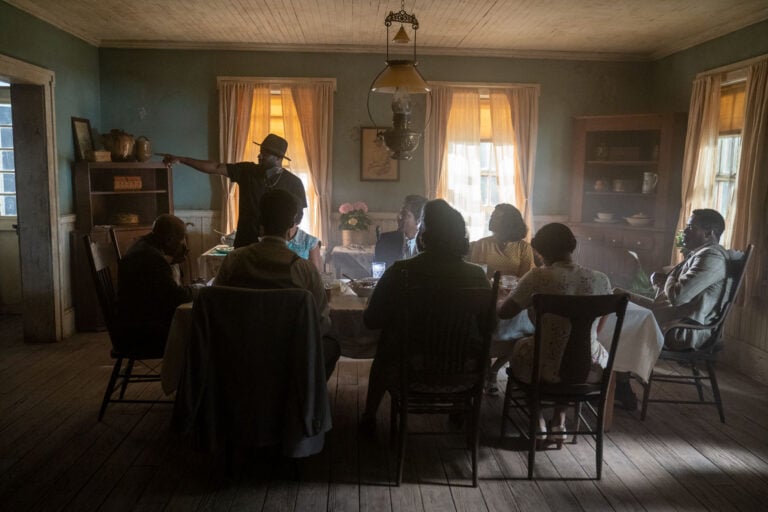
One of the signature lines of Steven Spielberg’s 1985 adaptation of The Color Purple is when Squeak indignantly asks Harpo, “Harpo, who dis woman?” in reference to Sofia. That line applies to every female character in this story, in the sense that they can ask this about themselves. From Shug Avery to Celie to Sofia to Nettie, every woman is on a voyage of self-discovery that jettisons through difficult circumstances to some semblance of freedom.
In director Blitz Bazawule’s adaptation of the Broadway musical, he kept the production authentic by going back to the source material of the story: “Whenever in doubt, we just went back to Alice Walker‘s brilliant Pulitzer Prize-winning novel. She’d given us the perfect poem. Our job was to find life in between the words.
Bazawule previously directed Beyonce’s visual album Black is King, which gave a vast audience exposure to his audacious visual style. With The Color Purple, he gets to extend his talents and fuse his Ghanian influences with his U.S. art.
“Being Ghanaian is critical to the way I see the world. It’s critical to how I see color,” he says. “I grew up in a very colorful environment. If you’ve seen African fabrics, there’s nothing more colorful than that. I don’t shy away from color. It’s something I lean deeply into.
“Also, I think music is a critical part of filmmaking in building a rhythm in a film. And because of my African syncopation, there is continental and Diaspora music. I always seek to make films the way I understand African music…its freedoms, its many manifestations, whether it’s on the continent with Afrobeats or in the Diaspora with jazz, blues, gospel, and such.
“They’re all a rhythm and a cadence and strong identity that I try to bring into my films and almost create an approximation between the sonic world and expanding that into a visual landscape,” he adds.

Director Blitz Bazawule (standing) with (L-R clockwise) Louis Gossett Jr., H.E.R., Jon Batiste, Taraji P. Henson, Colman Domingo, Fantasia Barrino, Danielle Brooks and Corey Hawkins on the set of The Color Purple, a Warner Bros. Pictures release. Photo by Eli Ade, courtesy Warner Bros. Pictures – Credit: C/O
Blitz Bazawule on Adapting The Color Purple From Broadway
When the original film came out in 1985, it was a critical success — but many Black organizations and people in the Black community weren’t happy with the portrayal of Black men as brutal, violent, and aggressively misogynistic. The themes of child rape, incest, and domestic violence are heavy. Bazawule’s retelling has more moments of levity than the original film, drawing from the 2005-08 Broadway run, in which Stephen Bray, Allee Willis, and Brenda Russell were responsible for the music and lyrics. Marsha Norman was the playwright.
What attracted Bazawule to the project was the possibility of getting into Celie’s headspace. “ I got a sense in the first page, the first words: ‘Dear God. I’m 14 years old.’ I thought, ‘Whoever can write letters to God must have a sprawling imagination.’That’s when I went, ‘Okay. There might be something here.’ I decided to lean further into Celie’s imaginative space. That’s when I thought we could contribute something tangible to the canon that is The Color Purple. And that’s when I said ‘yes.’”
Filming a musical isn’t like filming a regular feature film. The timing is different for shooting scenes and many more things have to be synchronized to make the magic happen. It’s even different from directing a stage musical.
“I don’t think I process this at all as a musical as much as massive, sprawling production,” he says. “That’s what was intimidating and restrictive, if anything at all. Several dance numbers, several bodies. There were also intimate scenes that required a lot of delicate framing. That’s what I had to contend with. How do you make a big movie that has massive set pieces but also needs to be deeply emotional and deeply cathartic at the end? That was my biggest challenge.”
Fantasia Barrino Taylor plays Celie, who suffers abominable brutality from almost every man she encounters. It’s not until she meets Shug Avery, a dazzling Taraji P. Henson, that she gets a glimmer of hope of what else is out in the world. Danielle Brooks jumps off the screen as the cantankerous and irascible Sofia. H.E.R. even gets to shine in the role of Squeak, aka Mary Agnes. Through this sisterhood, Celie discovers the true meaning of home.
“Celie defines home as a place where there’s love. She’s able to find that herself because where she is, there is no love. Her whole journey until the end of the movie is in search of this home, which is a loving space.”
Bazawule found that Fantasia’s performance of “I’m Here” wasn’t only a healing moment for the character of Celie, but also personally for the actress who plays her.
“There were bigger scenes that were more exciting to shoot, This one was spiritual. It was watching Fantasia arrive at a place in her personal life and career where I could see her letting go of her personal baggage and seeking her own healing through the performance of this work,” he says. “And that, as an artist of any sort, we do this to heal a part of ourselves. For me, to watch her do that was healing to me.”
This Celie is a little different than the one in the 1985 version. In the original, it takes her awhile to find her voice, and she’s what can be construed as docile for a great deal of the film. In this version, her character has a longer arc.
“You’re not watching a character being mischaracterized as being docile and passive and waiting to be saved,” says Bazawule. “You’re watching somebody actively work to liberate herself in her head. She’s learning who to love, how to love, how to forgive, how to conjure her sister back from Africa. Her character is so much more active than the one we’ve seen before.”
Bazawule also sought authenticity by hiring people proximate to the culture being explored, whether it was Black life in the rural South or on the African continent.
“It was important that we found authentic artisans, to make sure that when we envision Africa, it is a specific culture, specific tribe with costumes, language and music and things we could harness. And not a mumbled jumbled version of Africa that you used to sometimes see in Hollywood productions,” he says.
“It was also choosing to shoot in the rural South, in Georgia. Hiring dialect coaches to walk through dialect and syntax. I also had a fantastic costumer, Francine Tanchuck, who had worked on Steven Spielberg’s film in 1985 as an assistant costumer and who rose to be my head costumer for this film.”
Producer Scott Sanders originally took the story to the stage in 2004, first in Atlanta, then to Broadway. Oprah Winfrey and Quincy Jones were also producers of the Broadway version. Winfrey, who starred as Sofia in the original film and was nominated for an Oscar for the role, is a producer on this version, along with Spielberg, Sanders, Jones, and Walker, in addition to other Hollywood notables.
Screenwriter Marcus Gardley crafted this version based on Walker’s novel and Norman’s Broadway adaptation.
Bazawule received a lot of acclaim for his low-budget first feature, 2019’s The Burial of Kojo. He assumed doing a bigger budget film would be different, but soon discovered that it isn’t.
“I learned that it’s all the same. Whether you’re making a small movie with a microbudget or with tens of millions of dollars. It’s all the same thing. You have to have a plan. You have to be very clear on how you communicate that plan, whether it’s to five people or five hundred people. It’s going to be all about what ends up in that can.”
What ended up in the can for The Color Purple is a colorful, glorious celebration of life and sisterhood.
The Color Purple will be in theaters Christmas day, from Warner Bros.
Main image: (L-R) Phylicia Peael Mpasi as Young Celie and Halle Bailey as Young Nettie in The Color Purple, a Warner Bros. Pictures release. Photo Courtesy Warner Bros. Pictures
